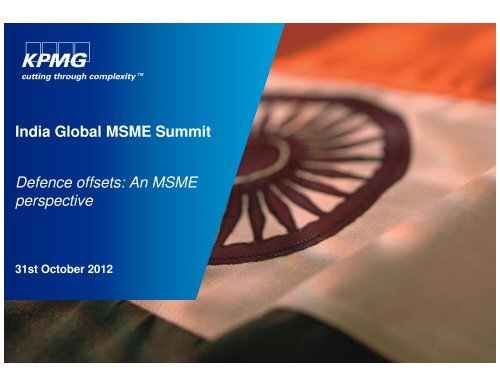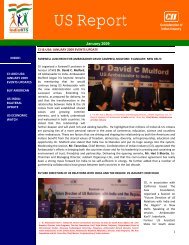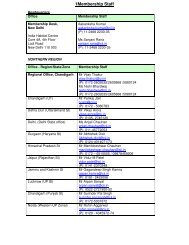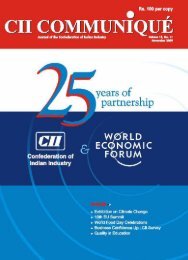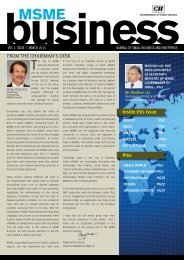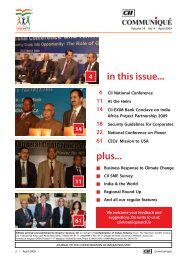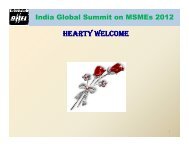India Global MSME Summit Defence offsets: An MSME ... - CII
India Global MSME Summit Defence offsets: An MSME ... - CII
India Global MSME Summit Defence offsets: An MSME ... - CII
You also want an ePaper? Increase the reach of your titles
YUMPU automatically turns print PDFs into web optimized ePapers that Google loves.
<strong>India</strong> <strong>Global</strong> <strong>MSME</strong> <strong>Summit</strong><br />
<strong>Defence</strong> <strong>offsets</strong>: <strong>An</strong> <strong>MSME</strong><br />
perspective<br />
31st October 2012
<strong>India</strong> is one of the most lucrative defence market in the world…..<br />
Canada<br />
$44 billion cuts<br />
over next 20<br />
years<br />
UK<br />
8% cuts<br />
through 2014<br />
Sweden<br />
$28 billion<br />
budget over<br />
2012–15<br />
Russia<br />
$100 billion<br />
new<br />
investment<br />
through 2020<br />
The<br />
Netherlands<br />
$1.4 billion<br />
cuts through<br />
2014<br />
Turkey<br />
Budget to be<br />
$40 billion in<br />
2015 vs. $20 bn<br />
in 2011<br />
US<br />
$1 trillion cuts<br />
over next<br />
decade<br />
France<br />
$4.9 billion<br />
cuts over<br />
2011–13<br />
Saudi Arabia<br />
Budget to be<br />
$84 billion in<br />
2015 vs. $47 bn<br />
in 2011<br />
<strong>India</strong><br />
12% increase<br />
in 2011 and<br />
$23.52 billion<br />
total by 2016<br />
Japan<br />
$9 billion cuts<br />
over<br />
2011–15<br />
Germany<br />
$11.8 billion<br />
cuts over<br />
2010–15<br />
Switzerland<br />
Budget<br />
approved but<br />
purchases<br />
delayed<br />
China<br />
13% increase in<br />
2011 to $100<br />
billion with further<br />
60% increase by<br />
2015<br />
Italy<br />
$2.1 billion<br />
decrease 2012<br />
vs. 2011<br />
Australia<br />
$4 billion in<br />
cuts through<br />
2015<br />
<strong>India</strong>’s defence expenditure on capital acquisition has been growing at a CAGR of 15% in the last 10 years<br />
© 2012 KPMG, an <strong>India</strong>n Partnership and a member firm of the KPMG network of independent member firms<br />
affiliated with KPMG International Cooperative (“KPMG International”), a Swiss entity. All rights reserved.<br />
1
MoD Contracts - <strong>An</strong>alysis<br />
By any standards these numbers are a sharp contrast to the global trend<br />
© 2012 KPMG, an <strong>India</strong>n Partnership and a member firm of the KPMG network of independent member firms<br />
affiliated with KPMG International Cooperative (“KPMG International”), a Swiss entity. All rights reserved.<br />
2
Offset Contracts - <strong>An</strong>alyzed<br />
The offset policy was introduced in 2005 and the first offset contract was signed in 2007, and since then:<br />
The US has signed offset contracts worth over $2 billion till date, while France has signed contracts worth<br />
$1 bn<br />
© 2012 KPMG, an <strong>India</strong>n Partnership and a member firm of the KPMG network of independent member firms<br />
affiliated with KPMG International Cooperative (“KPMG International”), a Swiss entity. All rights reserved.<br />
3
Key Providers of arms and armament in the <strong>India</strong>n defence sector<br />
DPSUs<br />
Foreign OEMs<br />
■ Legacy tie ups with foreign OEMs for domestic<br />
production through Transfer of Technology.<br />
Eg. MIGs, Sukhois, T-72<br />
■ Have developed and acquired new<br />
technologies<br />
■ Grown tremendously through protection,<br />
monopoly<br />
■ SMEs have been supporting these programs<br />
by providing small scale components<br />
■ <strong>India</strong> is the largest importer of weaponry in the<br />
world<br />
■ Foreign OEMs have been providing equipment<br />
to the armed forces directly or through<br />
Technology transfer to mainly <strong>India</strong>n DPSUs<br />
■ The OEMs have predominantly had a buyer –<br />
seller relationship with the MoD<br />
■ <strong>India</strong>’s Large defence requirements are now<br />
linked to <strong>offsets</strong> and therefore OEMs are now<br />
evolving the <strong>India</strong>n private sector<br />
© 2012 KPMG, an <strong>India</strong>n Partnership and a member firm of the KPMG network of independent member firms<br />
affiliated with KPMG International Cooperative (“KPMG International”), a Swiss entity. All rights reserved.<br />
4
Limited involvement of private sector and <strong>MSME</strong>s<br />
<br />
<br />
<br />
<br />
<strong>India</strong>n private sector typically relatively less involved in the <strong>India</strong>n defense market compared<br />
to public firms<br />
However, in recent times, private <strong>India</strong>n firms aggressively expanding their interest in<br />
becoming <strong>India</strong>'s partners for the development of indigenous programs (through <strong>offsets</strong>)<br />
As of now, a large portion of offset related contracts have been signed by large corporate<br />
which will eventually be outsourced to the SMEs<br />
Hence, there is a clear need to develop <strong>India</strong>n, small, and medium enterprises (in the<br />
development and manufacture of defense equipment) and help these firms augment their size<br />
and core competency<br />
© 2012 KPMG, an <strong>India</strong>n Partnership and a member firm of the KPMG network of independent member firms<br />
affiliated with KPMG International Cooperative (“KPMG International”), a Swiss entity. All rights reserved.<br />
5
<strong>Defence</strong> <strong>MSME</strong> SWOT<br />
■ Flexibility and efficiency in operation<br />
■ Innovative technologies<br />
■ Specialised capabilities<br />
■ Minimal engineering costs<br />
■ Inability to provide end to end supply chain support<br />
■ Inability to export sub-assemblies independently of<br />
OEMs<br />
■ Delay in R&D investment and achieving returns<br />
■ Insufficient capital<br />
Strengths<br />
Weaknesses<br />
SWOT <strong>An</strong>alysis<br />
■ Large and growing domestic market<br />
■ Indigenization thrust from Government of <strong>India</strong><br />
■ <strong>Defence</strong> offset policy<br />
Opportunity<br />
■ Outsourcing of global defence manufacturing to<br />
<strong>India</strong><br />
■ Collaboration with Foreign vendors to become part<br />
of the global supply chain<br />
Threat<br />
■ Foreign SMEs in <strong>India</strong><br />
■ Lack of information on current and future capability<br />
requirements and partnering opportunities<br />
■ Delay in responding to market needs<br />
■ Ambiguous regulations - IL, FDI, EXIM<br />
© 2012 KPMG, an <strong>India</strong>n Partnership and a member firm of the KPMG network of independent member firms<br />
affiliated with KPMG International Cooperative (“KPMG International”), a Swiss entity. All rights reserved.<br />
6
<strong>MSME</strong>s – Current status check and need of the hour<br />
Current status<br />
Need of the hour<br />
• ~ 5,000 SMEs operate in the<br />
defence sector in <strong>India</strong>,<br />
supplying components and<br />
sub–assemblies<br />
• Primarily come into existence<br />
due to outsourcing<br />
requirements of the<br />
government DPSUs<br />
• Have acquired basic quality<br />
certifications and supply<br />
chain capabilities, however<br />
growth highly dependent on<br />
the order inflow from<br />
government companies<br />
<strong>India</strong>n MoD’s aim<br />
To increase the<br />
interest of foreign<br />
companies and bring<br />
in more investments<br />
in <strong>India</strong> through joint<br />
ventures (JVs), and<br />
partnerships, and<br />
formation of an<br />
industrial base to<br />
develop indigenous /<br />
localized programs<br />
• Strong need for skill, process<br />
and infrastructure<br />
development to help upgrade<br />
functioning while performing<br />
offset projects with global<br />
partners<br />
• Develop the requisite long<br />
term mindset to have a<br />
sustainable play in the<br />
defence sector<br />
• Develop quality and cost<br />
control mechanism<br />
• Follow strict accounting,<br />
financial and regulations<br />
© 2012 KPMG, an <strong>India</strong>n Partnership and a member firm of the KPMG network of independent member firms<br />
affiliated with KPMG International Cooperative (“KPMG International”), a Swiss entity. All rights reserved.<br />
7
<strong>MSME</strong> specific Multipliers introduced<br />
The government realizes that <strong>India</strong>n micro, small and medium scale organizations would<br />
play a pivotal role in <strong>India</strong>’s quest for self reliance in developing defence manufacturing<br />
capability through effective offset policy implementation<br />
Category Export FDI<br />
Description<br />
of category<br />
Valuation<br />
of offset<br />
credits<br />
Multiplier<br />
Discharge<br />
Executing export orders for<br />
eligible products/ services.<br />
• Amount of exported<br />
products/ services subject<br />
to value addition in <strong>India</strong><br />
• Value addition = export<br />
amount – (imported<br />
component + Fee/ Royalty)<br />
1.5 if IOP is a <strong>MSME</strong><br />
FDI in <strong>India</strong>n<br />
enterprises, for<br />
manufacture and /<br />
or maintenance of<br />
eligible products /<br />
services.<br />
Amount of FDI<br />
(equity<br />
investment)<br />
1.5 if IOP is a<br />
<strong>MSME</strong><br />
70% minimum<br />
TOT to <strong>India</strong>n<br />
Enterprise<br />
TOT to <strong>India</strong>n<br />
enterprises for<br />
manufacture and /<br />
or maintenance of<br />
eligible products /<br />
services<br />
10% of value of<br />
buyback of eligible<br />
products/ services<br />
to the extent of<br />
value addition in<br />
<strong>India</strong>.<br />
1.5 if IOP is a<br />
<strong>MSME</strong><br />
Transfer of equipment<br />
to <strong>India</strong>n enterprise<br />
Investment in ‘Kind’ in<br />
<strong>India</strong>n enterprises through<br />
the non-equity route for<br />
manufacture and / or<br />
maintenance of eligible<br />
products/ services<br />
-<br />
1.5 if IOP is a <strong>MSME</strong><br />
© 2012 KPMG, an <strong>India</strong>n Partnership and a member firm of the KPMG network of independent member firms<br />
affiliated with KPMG International Cooperative (“KPMG International”), a Swiss entity. All rights reserved.<br />
8
Challenges remain<br />
Single customer: <strong>MSME</strong>s working for the defence sector are generally solely dependent on the defence<br />
departments such as DPSUs and DRDO etc for their orders. Moreover, as production targets vary on an<br />
annual basis, sourcing of components/sub-assemblies from SMEs is not a constant and sustained activity.<br />
Technology Limitation: Most defence systems are based on foreign design and the complete technology is<br />
not available with the production agency. Hence <strong>MSME</strong>s are often unable to gain access and guidance on<br />
the desired technology. They also lack awareness of IPR and other legal issues.<br />
Limitations in innovation: The SME segment, with limited business support and research base, is not<br />
always competent to meet the current requirements.<br />
Certification and quality issues: Getting certifications for processes and quality checks, which are an<br />
essential requirement for OEMs is a challenge for <strong>India</strong>-based <strong>MSME</strong>s<br />
Small capital base: <strong>MSME</strong>s have a small capital base and generally require immediate cash payment.<br />
They cannot withstand payment delays, which are inherent in government accounting and audit procedures.<br />
© 2012 KPMG, an <strong>India</strong>n Partnership and a member firm of the KPMG network of independent member firms<br />
affiliated with KPMG International Cooperative (“KPMG International”), a Swiss entity. All rights reserved.<br />
9
<strong>MSME</strong> Expectations from the Government<br />
Even though the government has been active in supporting the development of <strong>MSME</strong>s..a<br />
lot more is desired<br />
•Governmental support in the form of Cluster Development for SMEs<br />
•Encouragement from the Government to focus on areas of strategic importance and gradually<br />
integrate the <strong>MSME</strong>s into non-strategic areas.<br />
•Promote the <strong>MSME</strong> sector to plan their investments and supply chain in advance through close<br />
involvement in planning and project categorization.<br />
• <strong>MSME</strong> participation in defence R&D should be actively encouraged and primarily financed by the<br />
government, given the fact that defence R&D is expensive and marked by an element of uncertainty<br />
•The licensing procedure for defence manufacturing should be streamlined to encourage entry of<br />
<strong>MSME</strong>s in the defence industry.<br />
© 2012 KPMG, an <strong>India</strong>n Partnership and a member firm of the KPMG network of independent member firms<br />
affiliated with KPMG International Cooperative (“KPMG International”), a Swiss entity. All rights reserved.<br />
10
Thank You<br />
Neelu Khatri<br />
Director and Head, Aerospace, <strong>Defence</strong> and Homeland Security<br />
KPMG in <strong>India</strong><br />
neelukhatri@kpmg.com<br />
+91 9810896334<br />
© 2012 KPMG, an <strong>India</strong>n Partnership and a member firm of the KPMG network of independent member firms<br />
affiliated with KPMG International Cooperative (“KPMG International”), a Swiss entity. All rights reserved.<br />
11


